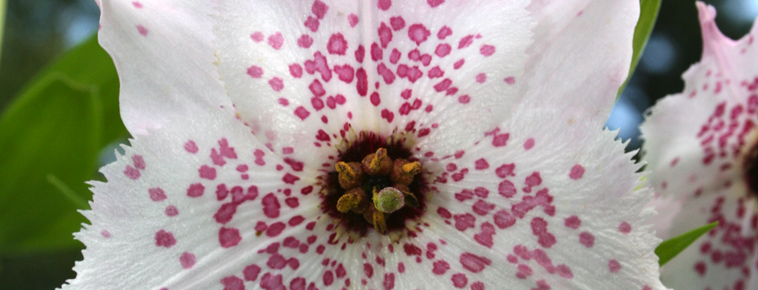
Species snippets
Here at Cluny House Gardens you will find a range of interesting flora and fauna. You can find out more by going to one of our designated ‘species lists’, on the left, or read on below to discover more about our friendly red squirrels.
Enjoy reading about the conifers, squirrels, wildflowers and birds and then come to our gardens to see them face to face!
THE CLUNY SQUIRRELS
Red Squirrels have been resident at Cluny for many years finding food and shelter within the large variety of established coniferous and deciduous trees. Numbers have increased in recent years perhaps as a result of increased artificial feeding and successful breeding seasons. As well as our own resident population, Red Squirrels from territories outside the garden also visit daily for food and can be seen climbing the fences or crossing branches overhanging the garden. Within the garden the squirrels have regular highways both on the ground and through the trees where they achieve some remarkable jumps from one branch to another. The two giant Sequioadendrons (Wellingtonia) are favourite haunts and the squirrels can often be seen and heard racing around on the soft bark of the trunk. They regularly appear on the lawn in front of the house sometimes stopping to scratch or pulling their bellies flat over the grass presumably in an attempt to rid themselves of parasites. A variety of different fungi found in the garden mainly in the late summer and autumn are important as a natural food source for the squirrels. They usually eat the fungi on the ground but they will also carry pieces up into the trees. Within the garden they have also been seen eating blossom of non-native trees, beech mast, walnuts, hips, cherries, lichen, coltsfoot leaves and of course wild hazelnuts. Bark is stripped off usually dead or dying trees and may be eaten but it is also used to line dreys. As autumn approaches, the squirrels bury food absolutely anywhere including in the lawn, in the compost heaps and even in plant pots!
With time and some patience individual squirrels can be recognised by the different shades of red in their fur particularly in their tails. Young ones have short ear tufts and tend to have better quality coats in the early summer when the adults are usually moulting. The squirrels at Cluny are approachable but not tame. However they can be photographed relatively easily if visitors are quiet and persevere particularly in the vicinity of the nut feeders.
The best times for viewing the squirrels are early in the morning and late afternoon especially during the longer summer days but in spring and autumn, they can be active for much of the day. Although Red Squirrels are supposed to be less active on cold winter days we usually see them on the feeders throughout much of the day and find their tracks in the snow. In really stormy weather, we have found dreys blown out of trees but fortunately squirrel casualties are unusual.
We feel very privileged to have a population of these extremely attractive and increasingly rare mammals enhancing Cluny’s wildlife. Long may they continue to captivate visitors and ourselves with their lively antics and photogenic poses.


